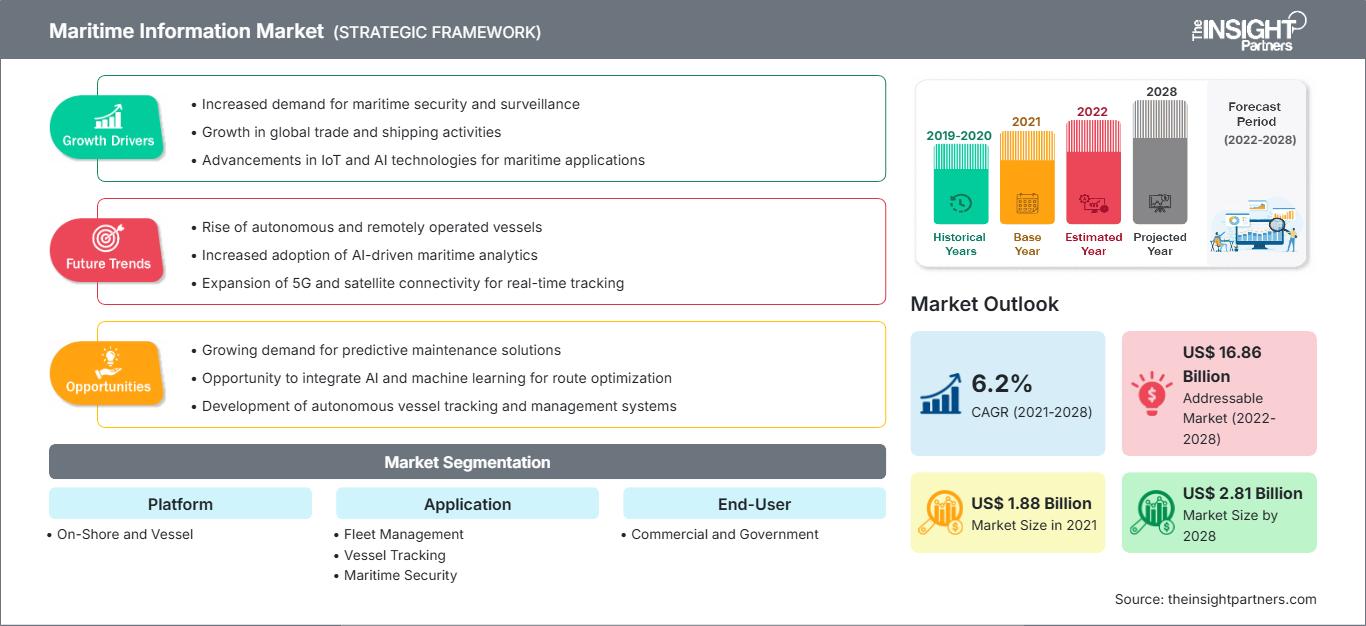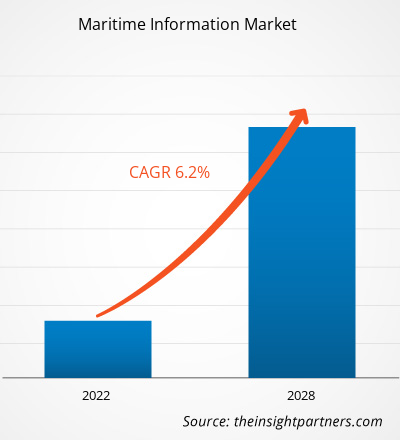Der Markt für maritime Informationen wurde im Jahr 2021 auf 1.882,01 Millionen US-Dollar geschätzt und soll von 2022 bis 2028 mit einer durchschnittlichen jährlichen Wachstumsrate von 6,2 % wachsen.
Die digitale Transformation in der maritimen Industrie hat es Nutzern ermöglicht, wichtige Informationen über Eigentum, Bewegung, Spezifikationen und kommerzielle Aktivitäten von Marineschiffen zu sammeln. Maritime Informationslösungen helfen Schiffen, sich an raue Seebedingungen anzupassen, indem sie mehrere Parameter überwachen, und ermöglichen Nutzern so, bessere strategische und operative Entscheidungen zu treffen. Darüber hinaus bieten diese Lösungen Vorteile wie verbesserte Produktivität und allgemeine Sicherheit bei gleichzeitiger Gewährleistung der Effizienz maritimer Operationen. Solche Faktoren stärken die Größe des Marktes für maritime Informationen.
Maritime Informationslösungen spielen eine wichtige Rolle bei der Gewährleistung der Sicherheit der Wirtschaft; daher werden diese Lösungen von Regierungsbehörden auf der ganzen Welt häufig eingesetzt. Diese Lösungen helfen verschiedenen Ländern, maritime Bedrohungen wie Menschenhandel, Terroranschläge, Umweltzerstörung und illegale Einwanderung über das Meer zu reduzieren. Darüber hinaus hat die Zahl der Schiffe, die die Ozeane überqueren, aufgrund der Liberalisierung des Welthandels deutlich zugenommen, was die Nachfrage nach diesen Lösungen ankurbelt. Darüber hinaus hat die Internationale Seeschifffahrtsorganisation (IMO) alle Schiffe dazu verpflichtet, über ein Automatisches Identifikationssystem (AIS) zu verfügen, um den Schiffsverkehr zu überwachen und Kollisionen mit anderen Schiffen zu vermeiden. Darüber hinaus finanzieren Hersteller in der Schifffahrtsbranche Forschungs- und Entwicklungsaktivitäten, um Signale von Marineschiffen genau erkennen zu können. Solche Faktoren stärken den Markt für maritime Informationen.
Angesichts des steigenden Schiffsverkehrs ist es unerlässlich geworden, die Sicherheit von Schiffen zu verbessern und ihre Umwelt zu schützen. So betrug beispielsweise der Frachtverkehr in den wichtigsten Häfen Indiens nach Angaben der indischen Hafenbehörde im Jahr 2020 414,20 Millionen Tonnen, was einem Anstieg von 12,9 % im Jahr 2021 gegenüber dem ersten Quartal 2020 entspricht. Darüber hinaus ermutigt der Informationsaustausch verschiedene Teile der Lieferkette der Schifffahrtsbranche, zusammenzuarbeiten, um einen reibungslosen Betrieb zu gewährleisten. Integrierte Systeme mit Funktionen zur Überwachung des Schiffsverkehrs und effektiven Ortungssystemen wie AIS und Synthetic Aperture Radar (SAR) sind für Schiffe unverzichtbar geworden, was zum Wachstum des maritimen Informationsmarktes beiträgt.
Passen Sie diesen Bericht Ihren Anforderungen an
Sie erhalten kostenlos Anpassungen an jedem Bericht, einschließlich Teilen dieses Berichts oder einer Analyse auf Länderebene, eines Excel-Datenpakets sowie tolle Angebote und Rabatte für Start-ups und Universitäten.
Maritimer Informationsmarkt: Strategische Einblicke

-
Holen Sie sich die wichtigsten Markttrends aus diesem Bericht.Dieses KOSTENLOSE Beispiel umfasst Datenanalysen, die von Markttrends bis hin zu Schätzungen und Prognosen reichen.
Einige der großen Unternehmen auf dem Markt für maritime Informationen sind Inmarsat, L3 Harris Technologies, ORBCOMM, Raytheon Company, Thales Group, exactEarth und Iridium Communications. So führte Spire Global im April 2022 Wetterinformationslösungen für die maritime Industrie ein. Das Unternehmen sammelt globale Wetterdaten über eine vollständig eingesetzte Konstellation von mehr als 100 Satelliten, die entlegene Gebiete, darunter auch offene Ozeane, erreichen, deren Beobachtung bisher schwierig war. Spiers liefert Erkenntnisse zum Wetter und spart Kunden Zeit und Kosten, indem es Wetterdaten mit maritimem Fachwissen durch maschinelles Lernen und künstliche Intelligenz kombiniert.
Im September 2022 kündigte BAE Systems seinen Plan an, bis 2024 den ersten Multisensor-Satellitencluster in eine niedrige Erdumlaufbahn zu bringen, um Militärkunden in Echtzeit hochwertige maritime Informationen und Erkenntnisse aus dem Weltraum zu liefern.
Auswirkungen der COVID-19-Pandemie auf das Wachstum des Marktes für maritime Informationen
Die COVID-19-Pandemie hatte langfristige Auswirkungen auf den Seehandel und -transport. Häfen, Schifffahrtsbetriebe und Lieferketten wurden durch die pandemiebedingten Einschränkungen negativ beeinflusst. Rohstoffknappheit, Lieferzeitprobleme, Leerfahrten, Hafenschließungen, verkürzte Hafenöffnungszeiten, Ausrüstungs- und Arbeitskräftemangel sowie Einschränkungen der Transportkapazität waren einige der Schwierigkeiten, mit denen Schiffsbetreiber während der Krise konfrontiert waren. Diese Behinderungen schädigen Transportdienstleistungen erheblich und gefährden den reibungslosen Ablauf von Lieferketten und Handelsströmen. Die Schifffahrtsbranche in mehreren Ländern und Regionen hat im Zusammenhang mit der COVID-19-Krise mehrere Rundschreiben zur Hafenschifffahrt herausgegeben.
Die Regierungen verschiedener Länder verhängten Reisebeschränkungen und schlossen Grenzen, um die Ausbreitung von SARS-CoV-2 einzudämmen. Infolgedessen wurden Häfen und Flughäfen geschlossen. Ungefähr 90 % des Welthandels werden auf dem Seeweg abgewickelt. Darüber hinaus haben die von den Regierungen verschiedener Länder verhängten sozialen und physischen Distanzierungsmaßnahmen die Hafenbehörden dazu veranlasst, ihren Schiffsbetrieb einzuschränken, was die Nachfrage nach maritimen Informations- und Analyselösungen reduzierte. Mit der Aufhebung der Ausgangssperren und erfolgreichen Impfprozessen im Jahr 2021 haben jedoch mehrere Unternehmen ihren Betrieb wieder aufgenommen, und die Lockerung der Reisebeschränkungen verhalf der Schifffahrtsbranche zu neuem Schwung. Daher stieg im Jahr 2021 die Nachfrage nach maritimen Informationslösungen weltweit.
Markteinblick – Markt für maritime Informationen
Effizientes Management komplexer Lieferkettenprozesse erforderlich
Die Schifffahrtsbranche nutzt die Digitalisierung, um ihre Effizienz zu steigern, intelligentere Schiffe und Flotten zu bauen und sich auf die Expansion des globalen Handels vorzubereiten. Globale Lieferketten wachsen und werden mit der steigenden Verbrauchernachfrage komplexer. Unternehmen der Schifffahrtsbranche müssen kontinuierlich neue Strategien entwickeln und umsetzen, um die Effizienz zu maximieren und Lieferketten im hart umkämpften globalen Markt zu optimieren. Die Integration innovativer Technologien wie KI, Blockchain, IoT und Automatisierung in maritime Abläufe ermöglicht die einfache Bereitstellung von Bestandsdaten, die Verfolgung und Verwaltung von Schiffen, die Nachverfolgung von Informationen und die Erstellung elektronischer Rechnungen. Mithilfe dieser Technologien können Reedereien den Zeitaufwand für Versand, Empfang, Nachverfolgung und Auftragserfassung reduzieren. Diese Technologien unterstützen die Entwicklung neuer Geschäftsfelder und die Transformation von Lieferketten. Endnutzer können Lieferkettenaktivitäten erfolgreich verwalten, indem sie Design- und Simulationstools, Lagerverwaltung, Transport- und Lagermanagement sowie eine durchgängige Logistiknetzwerksteuerung mithilfe maritimer Informationen nutzen. Darüber hinaus beeinflussen strengere Umweltvorschriften weiterhin die Seetransportbranche, da Transportunternehmen Kosten sparen und Nachhaltigkeit im Betrieb sicherstellen müssen. Der zunehmende Bedarf an effizienter Verwaltung komplexer Lieferkettenabläufe treibt daher den Marktanteil maritimer Informationen voran.
Plattformbasierte Erkenntnisse
Der Markt für maritime Informationen ist nach Plattform, Anwendung und Endnutzer segmentiert. Basierend auf der Plattform wird der Markt für maritime Informationen in Onshore und Schiff unterteilt. Das Schiffssegment hatte 2021 einen größeren Marktanteil. Unternehmen, die im Markt für maritime Informationen tätig sind, bieten eine Reihe von maritimen Lösungen und Dienstleistungen für eine Flotte von Offshore-Schiffen an, die ein breites Spektrum komplexer maritimer Projekte bedienen können. Moderne Flotten verfügen über neue Technologien, effiziente Antriebssysteme und bewährte Zuverlässigkeit, um ein breites Spektrum an Dienstleistungen wie Unterwasserbau und Schlepparbeiten abzudecken. Eine wachsende Zahl von Flottenschiffen erhöht die Nachfrage nach fortschrittlicher maritimer Informationssoftware und -dienstleistungen für Schiffsbetrieb und -management und treibt das Marktwachstum voran.
Maritimer Informationsmarkt
Die Analysten von The Insight Partners haben die regionalen Trends und Faktoren, die den Markt für maritime Informationen im Prognosezeitraum beeinflussen, ausführlich erläutert. In diesem Abschnitt werden auch die Marktsegmente und die geografische Lage in Nordamerika, Europa, dem asiatisch-pazifischen Raum, dem Nahen Osten und Afrika sowie Süd- und Mittelamerika erörtert.Umfang des Marktberichts über maritime Informationen
| Berichtsattribut | Einzelheiten |
|---|---|
| Marktgröße in 2021 | US$ 1.88 Billion |
| Marktgröße nach 2028 | US$ 2.81 Billion |
| Globale CAGR (2021 - 2028) | 6.2% |
| Historische Daten | 2019-2020 |
| Prognosezeitraum | 2022-2028 |
| Abgedeckte Segmente |
By Plattform
|
| Abgedeckte Regionen und Länder |
Nordamerika
|
| Marktführer und wichtige Unternehmensprofile |
|
Dichte der Akteure auf dem maritimen Informationsmarkt: Verständnis ihrer Auswirkungen auf die Geschäftsdynamik
Der Markt für maritime Informationen wächst rasant. Die steigende Nachfrage der Endnutzer ist auf Faktoren wie veränderte Verbraucherpräferenzen, technologische Fortschritte und ein stärkeres Bewusstsein für die Produktvorteile zurückzuführen. Mit der steigenden Nachfrage erweitern Unternehmen ihr Angebot, entwickeln Innovationen, um den Bedürfnissen der Verbraucher gerecht zu werden, und nutzen neue Trends, was das Marktwachstum weiter ankurbelt.

- Holen Sie sich die Maritimer Informationsmarkt Übersicht der wichtigsten Akteure
Akteure auf dem Markt für maritime Informationen konzentrieren sich hauptsächlich auf die Entwicklung fortschrittlicher und effizienter Produkte.
- Im Oktober 2021 kündigte Spire Global, Inc., ein globaler Anbieter weltraumgestützter Daten und Analysen, die Verfügbarkeit von Maritime 2.0 an, einem Update der maritimen Lösungen von Spire, das maritime Daten zu Schiffsstandorten, Wetterbedingungen und globalen Schifffahrtsaktivitäten liefert und so Entscheidungen in Echtzeit optimieren kann.
- Im September 2022 gab Iridium Communications Inc. bekannt, dass sich die Jan De Nul Group, ein führendes Unternehmen im maritimen Bau- und Tiefbau, für das Global Maritime Distress and Safety System von Iridium entschieden hat. Mit der Einführung von Iridium GMDSS bekräftigt Jan De Nul sein Bekenntnis, seinen Mitarbeitern die sicherste Betriebsumgebung zu bieten, die möglich ist.
Der Markt für maritime Informationen ist nach Plattform, Anwendung und Endnutzer segmentiert. Basierend auf der Plattform ist der Markt in Onshore und Schiff unterteilt. Der Markt ist je nach Anwendung in Flottenmanagement, Schiffsverfolgung und maritime Sicherheit unterteilt. Je nach Endnutzer ist der Markt in kommerzielle und staatliche Bereiche unterteilt.
Der Markt für maritime Informationen ist in fünf Hauptregionen unterteilt: Nordamerika, Europa, Asien-Pazifik (APAC), Naher Osten und Afrika (MEA) sowie Südamerika (SAM). Im Jahr 2021 führte Europa den Markt mit einem beträchtlichen Umsatzanteil an, gefolgt von Nordamerika und dem Asien-Pazifik-Raum. Die Marktanalyse für maritime Informationen hilft, die kommenden Trends, neuen Technologien sowie Makro- und Mikrofaktoren zu verstehen, die das Marktwachstum in den kommenden Jahren voraussichtlich beeinflussen werden.
Firmenprofil:
- BAE Systems Plc
- Spire Global
- Iridium Communications Inc
- L3Harris Technologies Inc
- Lockheed Martin Corp
- ORBCOMM Inc
- Saab AB
- Thales Group
- Windward Ltd
- Northrop Grumman Corp
- Polestar
- Oneocean
- Fujitsu Limited
- Siemens AG
- Historische Analyse (2 Jahre), Basisjahr, Prognose (7 Jahre) mit CAGR
- PEST- und SWOT-Analyse
- Marktgröße Wert/Volumen – Global, Regional, Land
- Branchen- und Wettbewerbslandschaft
- Excel-Datensatz
Aktuelle Berichte
Erfahrungsberichte
Grund zum Kauf
- Fundierte Entscheidungsfindung
- Marktdynamik verstehen
- Wettbewerbsanalyse
- Kundeneinblicke
- Marktprognosen
- Risikominimierung
- Strategische Planung
- Investitionsbegründung
- Identifizierung neuer Märkte
- Verbesserung von Marketingstrategien
- Steigerung der Betriebseffizienz
- Anpassung an regulatorische Trends






















 Kostenlose Probe anfordern für - Maritimer Informationsmarkt
Kostenlose Probe anfordern für - Maritimer Informationsmarkt